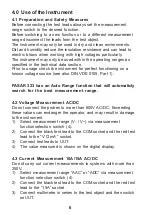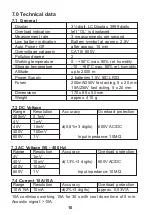
9
6)
Replace the case cover and retighten the screws.
Now the measurings can be carried out as normal.
Please help care for our environment, do not throw the used battery
in the normal household dustbin, make sure it is disposed of as
hazardous waste, or collected for recycling.
If an instrument is not used over an extended time period, the
batteries must be removed.
6.2 Fuse replacement
If a fuse has tripped by overload or wrong operation it must be
replaced.
Exclusively use fuses of voltage and current values in compliance
with the technical data section.
Only use fuses: 200mA fast acting / 250V, 5 x 20mm,
10A fast acting / 250V, 5 x 20 mm.
1)
Prior to fuse replacement, disconnect the instrument from any
circuit.
2)
Switch off instrument.
3)
Loosen the screws on the instrument rear. Lift the case cover.
4)
Remove the defect fuse and insert as new fuse of the same
type.
Using auxiliary fuses, in particular short-circuiting fuse holders is
prohibited and can cause instrument destruction or serious bodily
injury of operator.
6.3 Cleaning
If the instrument is dirty after daily useage, it is adviseable to clean it
by using a damp cloth and a mild household detergent. Never use
acid detergents or dissolvents for cleaning.












